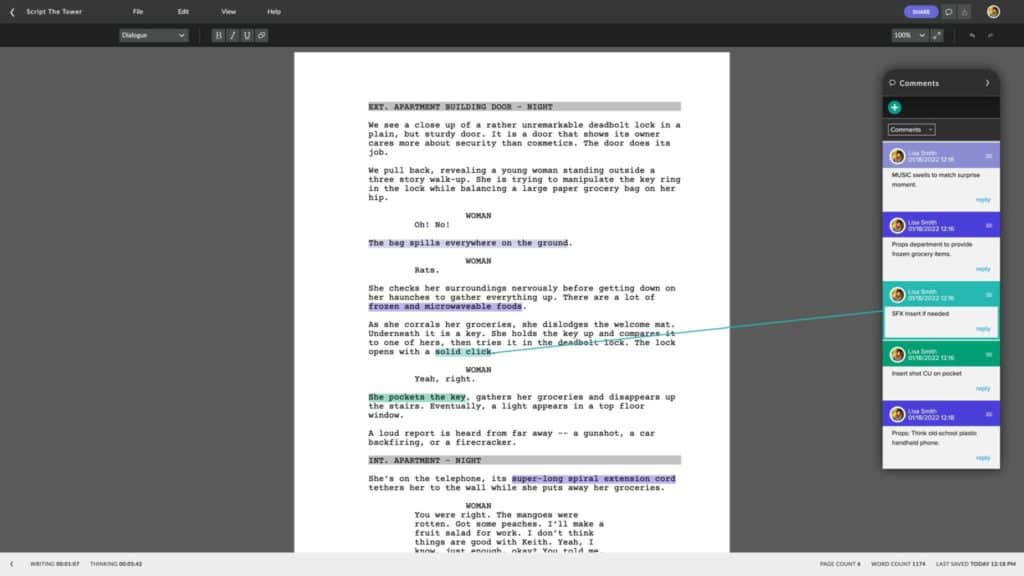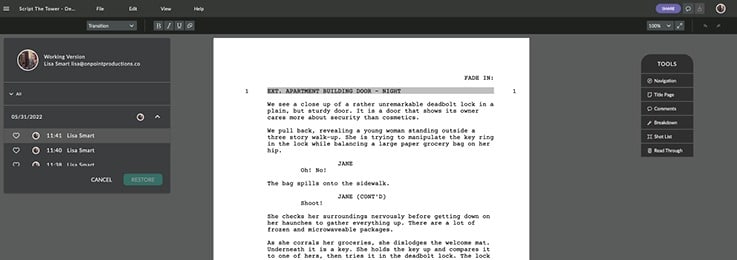Screenwriting is hard work, and most screenwriters would probably agree that the process of editing your screenplay is even harder.
The most important thing to remember is that these are entirely different processes! Don’t slow yourself down or get lost in the weeds by trying to edit as you write; never in the history of writing has this been an efficient or altogether constructive method.
Instead, get that first draft done, take a much-needed break, and then sit back down at your desk to begin the process of script editing. Editing requires a whole separate level of thoughtfulness and detail orientation, but a few basic tips — replacing dialogue, formatting properly, checking pacing, etc. — can help make the daunting process of script editing a lot more accessible.
But hold up, before we go any further, it might be a good idea to talk about what screenplay editing actually is.
Screenplay editing is the process of reviewing and revising a script for a film, television show, or stage play. It involves correcting grammar and formatting errors, improving the flow and pacing of the story, and making suggestions for changes to characters and dialogue.
Try Celtx’s FREE Script Editing Tool. Get Started Today.

While writing that first draft used up the creative, right-side of your brain, editing requires more of that technical and logical left-side. For some in Hollywood, script editing is outsourced to other writers, but for up and comers, the responsibility falls squarely on your shoulders.
It’s not challenging, per se, but script editing requires discipline, creative maturity, and the ability to look at your own work objectively, with as little bias as possible. (Top tip: the more you’re able to view and edit your script from an unbiased and third party perspective, the better your script will be.)
Here are 9 terrific tips to help you in editing your next screenplay and convert it into the best and most Hollywood-ready version of itself.
| 9 Tips for Editing a Screenplay |
|---|
| 1. Follow Basic Script Formatting Rules |
| 2. Rearrange Scenes for Pacing |
| 3. Take a Break |
| 4. Don’t Get Married to Your First Draft |
| 5. Ask Yourself, “Does This Advance My Story?” |
| 6. Rethink Your Dialogue |
| 7. Replace Your Dialogue |
| 8. Check for Common Formatting Mistakes |
| 9. Spell-Check and Grammar-Check |
1. Follow Basic Script Formatting Rules
It doesn’t matter if you have the most mind-blowing, Oscar-worthy screenplay ever written: if your script doesn’t look like a professional script, it will never even make it to a producer’s desk.
There’s a set of rules that are completely standardized across the entertainment industry, meaning screenplays for movies, television, video games, web series, and so on all share the same uniform look.
To be taken seriously, your script needs to wear this same uniform. Below are some of the most essentials dimensions and specifications that give your screenplay that distinctive “screenplay” look.

Follow these guidelines closely (or, better yet, use one of the many screenwriting software that automates all of this work for you.
- 12-point Courier font (to create the perfect 1 page = 1 minute ratio)
- 1.5-inch left margin
- 1-inch right margin
- 1-inch top and bottom margins
- Approximately 55 lines per page on 8.5 x 11” standard paper (but should be adjusted proportionally if printed on smaller paper)
- Pages should be numbered in the top right corner, exactly 0.5 inches from the top of the page and flush to the right margin (the only exception here is the Title Page and the first page of your screenplay, neither of which are numbered). These should always be followed by a period.
- Dialogue speaker names are in ALL CAPS 3.7 inches from the left side of the page
- Parentheticals within dialogue are 3.1 inches from the left side of the page
- Dialogue is placed directly below speaking character’s name and 2.5 inches from left side of page
Voila! Your script just went from messy Word doc to professional and industry-standard screenplay with those few rules.
(Take a much deeper look at screenplay formatting rules on our in-depth blog)
2. Rearrange Scenes for Pacing
All the steps above have hopefully reduced your page count slightly and helped your script become a little leaner and meaner.
On your next read-through, focus on the cadence of your script. Pay special attention to the rhythm of your narrative and get a sense of its overall pace. Does it sag anywhere? Are there any natural lulls? Do you lose momentum at any point, or undercut the drama of one scene with a boring subsequent scene?

Every script needs helps with pacing in at least some areas, and a huge way to help with this effort is simply by rearranging scenes. Take a look at each individual scene’s relationship to those around it. Does one slow the other? Does one contradict the other?
Unless the scenes are directly related, they can often be moved around slightly to help create a more even ride for your viewers. This can help your film play more evenly and prevent audiences from losing interest or missing important details. Even small changes in sequencing can help speed up slower areas and improve the cadence of your story.
3. Take a Break
Seriously!
With all due respect, you’ve been too close to your script for too long! A little time and space is essential to help you see your story objectively, and for its flaws (sorry, but no matter who you are, your script does have flaws) to come to light in a way that wasn’t possible before. Only a little separation can afford you that clarity.
Just as you’ve told your characters to do, take a beat. Go on a long hike through the woods, or go camping. Read a book. Hang out with your friends and family. Give yourself at least a week or two to reset your brain and allow it to do anything except obsessively think about the script you’ve been pouring over for weeks, months, or years.
At a certain point, the creative brain needs a recalibration to think clearly again.
When you’re too close for too long, you become blind to the flaws and married to certain plot points, interactions, jokes, etc. that have too much personal value and not enough audience or story value.
It’s challenging, and perhaps not the most intuitive first-step in the editing process, but like any healthy relationship to proposer long-term, you and your script need some time and space. Do yourself a favor and think about anything else for a little while.

4. Don’t Get Married to Your First Draft
Easier said than done, right?
This comes naturally to no one, but the more seasoned you become as a screenwriter, the better you’ll be at separating yourself from your own first draft.
Taking a break after completing your first draft plays a vital role in this crucial effort: eliminating your own bias.
Surely your script is full of good ideas, but the best ideas come from revising, refining, and building on those initial thoughts. It’s about distinguishing between the “objectively useful” and the “personally preferred” elements of your script, or the elements that genuinely appeal to your audience and serve an active function in your narrative versus the moments, jokes, or interactions that you like or are proud of.
Don’t be precious about your first draft! No matter how much you personally enjoy it or how proud of it you may be, accept that it can be even better. If all goes well, your first draft will be the worst version you produce! Even the best scripts in Hollywood history went through dozens and dozens of revisions to get them to their now-beloved places.
It’s an ongoing, iterative process, so accept it’s going to take time and finessing to get your script into the best possible place.
5. Ask Yourself, “Does This Advance My Story?”
Does that scene push your story forward or just include a hilarious joke? Is this scene necessary to understand the story or does it just feature an awesome location? Or an exciting character dynamic?
As you reread (and reread and reread) your first draft, ask yourself at each scene: “Does this advance my story?” If a scene, conversation, or plot points doesn’t advance our understanding of your characters, dimensionalize your world, or push the larger story forward in some way, get rid of it!
You, your narrative, and ultimately the readers/viewers on the other end will all benefit from a tighter, more focussed script. There’s plenty of room down the road to add creative flourishes and details that help contextualize your storytelling efforts.
For right now, however, focus on making your story as lean and powerful as possible.
Too many writers get lost in the “art” of screenwriting. Perhaps this isn’t the most inspiring perspective, but the reality is you’re not writing a novel, a poem, or a written piece of art: you’re writing a means to art, a technical document that outlines narrative mechanics for the purposes of visual storytelling.
That’s not the commencement speech that will inspire a new generation of screenwriters, but it’s a necessary perspective you need to assume to ensure your script serves its ultimate function: providing a roadmap for how to produce a piece of visual art. If a scene isn’t moving your story forward, it’s ultimately in the way of this end-goal.
6. Rethink Your Dialogue
Dialogue is an art form all its own, and even the most established screenwriters in the world can struggle with maintaining authenticity and believability in how they voice their characters. As you start your script editing, take a fresh look at your dialogue.
Have you embodied your character’s voice or are you parroting your own . . . or someone else’s? Is your character’s voice distinct from others? Does your character speak like an actual human being or like a character in a film of TV show?
Related Article by Celtx: How to Write a Script for TV (Beginner’s Guide)

This can be hard work, but perform a full quality check of all dialogue specifically to make sure it sounds believable. Common mistakes screenwriters often make is having their characters tell their story for them, so make sure interactions sound natural and not mechanical.
Also remember that less is often more with dialogue, and your characters probably don’t need to say as much as you think they do.
Remember: they’ll ultimately be played by actors, whose craft is telling stories without words. Let their performances do the talking for you.
7. Replace Your Dialogue
“Show don’t tell!” It’s the oldest adage in the storytelling book. A cardinal sin of the budding screenwriter is using dialogue to explain plot points instead of letting your movie do the work for you.
Unless an excess of dialogue is a deliberate stylistic choice (think fast-talking movies like anything Aaron Sorkin has written), your script should never rely on character dialogue to “tell” your story for you. Remember: this is a visual medium, and you need to take full advantage of what the medium can offer to create effective storytelling on-screen.
Dialogue needs to tell the story of your characters but shouldn’t be the driving force of your entire narrative. Reread each line of dialogue and double check you’re not using it as a narrative crutch. If you are, either revise the dialogue, trim it, or get rid of it altogether.
Better yet, convert your dialogue into action descriptions that show the audience your story instead. Eventually, this habit will become second-nature, just as it has for all professional screenwriters.
Remember: it’s not your characters’ responsibility to tell your story for you. Let the visuals tell your story!
8. Check for Common Formatting Mistakes
The basic formatting rules above provide a great baseline for creating a professional-looking script. That said, this is a long-standing traditional with a laundry list of rules . . . and easy mistakes for on-the-rise screenwriters to make.
Go back through your script and focused exclusively on double-checking for any formatting errors. These are super common mistakes that just about ever screenwriter makes as they’re typing their way through a creative burst, but these easily-made errors can have a domino effect and cause other elements to fall through the cracks.
We’re trying to make it as easy as possible for a Producer, as well as the audience at large, to understand and feel compelled by your story. These are some of the ways you can ensure your script is in tip-top shape, and as easy-to-read as can be:
- CHARACTER NAMES: Whether your character changes identity or adopts a new nickname over the course of the story, it’s important that your character name in the script remains consistent from beginning to end. This avoids any potential confusion for the reader. If a nickname must be included, make sure your format accordingly: ORIGINAL NAME (NEW NAME)
- SCENE LOCATIONS: For all the same reasons, scene locations also need to remain consistent throughout your script. Using different labels or titles for the exact same location is the easiest way to confuse everyone. Ensure this element is consistent throughout your whole screenplay so both readers and software get an accurate location count
- SCENE NUMBERS: Make sure scene numbers are added to every single scene. Screenwriting software will automatically generate these for you in chronological order. If numbering by hand, every scene with a SCENE HEADING needs to be numbered in order, with numbers placed in both the left and right hand margins.
- SCENE HEADERS: As a general rule, use only interior (INT.) or exterior (EXT.) or day (D) and night (N) within your scene headers, even if the light transitions or characters move from inside to outside mid scene. Adhering to binary labels makes your screenplay easier to read for producers and software alike. Later, you can further segment into INT./EXT. or specific times of day.
You Can Do All of This With Celtx. Try Today for FREE.
9. Spell-Check and Grammar-Check
We saved the best, most obvious, and most CRUCIAL tip for last: spell check spell check spell check!
The quality of your story matters not if you submit a script riddled with spelling errors, grammatical mistakes, poor punctuation, etc. It is any Producer’s first and easiest reason to disqualify any screenplay from consideration.
It’s annoying and yes, you’ve already read your script 10,000 ways to Sunday, but read through just one more time to make sure your script looks as professional and buttoned up as possible. Better yet, have someone else read it so they can specifically pay attention to spelling and grammar, rather than story.
You owe it to yourself and your script not to let your immense amount of handwork be undone by poor table manners. Producers are fickle creatures, and to effectively appeal to them, your script needs to look and play the part!
Conclusion
You did it! You’ve not only written an entire screenplay, you’ve now fully-edited that screenplay and helped it evolve from a first draft to a seasoned and polished second draft! That’s a massive feat and you should give yourself a huge pat on the back for making it this far.
The next step? Take a break. You’ll be exhausted of your own story after combing through it so many times, and some healthy separation always provides creative clarity. You can also take a look at some of our other helpful blogs for up-and-coming screenwriters to learn everything they need to know about going from first idea to market-ready script.
Once you’re happy with your fully-edited script, it’s ready for the great big world of screenwriting professionals to gobble it up and make it even better. You’re well on your way to screenwriting success!
Frequently Asked Questions
What are Screenplay Editing Services?
Screenplay editing services are professional services offered to screenwriters to refine and improve their scripts. These services typically include in-depth manuscript evaluations, line-editing and script coverage. In addition, these services aim to make the script more polished, professional and marketable by providing feedback on the story, characters, dialogue, pacing and formatting.

